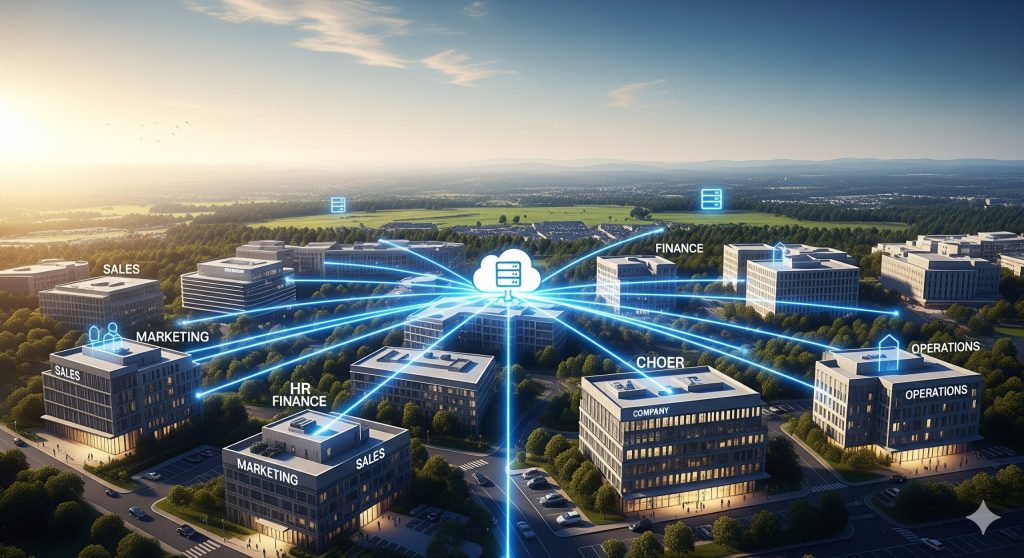
Introduction: The Efficiency Promise Too Good to Be True?
Every business leader dreams of improving efficiency, lowering costs and boosting productivity. Business software is often presented as the key to unlocking these goals. Vendors push tools claiming to automate processes, eliminate errors and transform operations. Headlines scream about skyrocketing ROI and seamless workflows.
But here’s the truth: How business software improves efficiency is rarely so straightforward. While the right software can help, over reliance on technology alone often leads to frustration, unforeseen costs and even less efficiency.
This blog unpacks the reality behind the efficiency claims. It offers a critical look at the benefits and drawbacks of business software, showing why a balanced perspective grounded in business needs, human factors and smart implementation must guide decisions.
Read on to understand the landscape fully, from the origins of business software to modern challenges and what this means for your company’s efficiency goals.
Timeline: Business Software and the Efficiency Myth
Understanding how efficiency became synonymous with business software demands a glance back through the decades:
- 1960s to 1980s: The first wave of business software was basic mostly accounting and inventory on mainframes. Efficiency was promised but limited by expensive hardware and technical expertise needs.
- 1990s to 2000s: Widespread adoption of PC and client server systems brought more automation to record keeping and reporting. Efficiency gains came but often involved manual data reconciliation and siloed systems.
- 2010s: Cloud computing and SaaS transformed availability and scalability. Software became more affordable, flexible but complexity grew, with many apps to manage and integrate.
- 2020s: AI, machine learning and automation hype raised expectations further. Organizations invested heavily in digital tools. However, user adoption, integration headaches and rising subscription costs tempered the promised efficiency gains.
Through history, efficiency gains via software were often partial and uneven. The “silver bullet” remains elusive.
How Business Software Can Improve Efficiency: The Common Claims
Before critiquing, let’s explore the typical ways business software is supposed to boost efficiency:
Automation of Routine Tasks
Software can automate repetitive processes like data entry, invoicing, inventory tracking and report generation. This automation saves time, reduces human error and enables employees to focus on higher-value work.
Real Time Data and Decision Making
With integrated dashboards and reporting tools, software delivers up to date business insights, enabling faster and more accurate decisions.
Improved Collaboration and Communication
Platforms that centralize information sharing break down silos and streamline workflows between teams and departments.
Streamlined Workflow and Task Management
Workflow automation and project management modules help ensure tasks move smoothly, deadlines are met and bottlenecks are visible.
Standardization and Process Control
Software can enforce best practices consistently across locations or teams, reducing variation and mistakes.
The Critical Reality Check: When Business Software Fails to Improve Efficiency
Despite the benefits, real world usage often uncovers difficulties that blunt or reverse efficiency gains:
1. Complexity Overload Too Many Features, Too Hard to Use
Modern business software often tries to do everything for everyone, resulting in bloated systems. Users confront:
- Confusing user interfaces.
- Steep learning curves.
- Overwhelming customization options.
Instead of speeding work, navigating complex software slows down employees, creating resistance and errors.
2. Poor Integration Creates Data Silos
Many companies use multiple standalone applications for sales, finance, HR and more. These systems don’t always “talk” to each other flawlessly:
- Manual data transfers multiply errors and waste time.
- Lack of a single source of truth clouds decision making.
Inefficient data flows and fragmented information hurt productivity far more than a single “new tool” can fix.
3. High Cost of Ownership and Hidden Expenses

Businesses often underestimate the full cost of software including:
- Implementation and customization fees.
- Staff training and ongoing support.
- Upgrades and add ons.
These expenses erode the ROI, sometimes forcing cutbacks in other critical areas.
4. Change Resistance and Culture Clashes
Employees may fear that new software complicates their jobs or threatens roles.
- Poor change management leads to low adoption and workarounds.
- Disconnect between IT decisions and user needs undermines potential.
Without buy in, software becomes dead weight, failing to drive efficiency improvements.
5. Overpromising and Underdelivering on Automation
Software vendors hype AI and automation as game changers. Yet:
- Automation often requires manual setup and ongoing tweaks.
- Many processes resist full automation due to variability or exceptions.
- Employees still need to monitor and intervene, reducing efficiency gains.
Overreliance on tech leads to disappointment when reality falls short.
Case Example: Enterprise Resource Planning (ERP) Systems
ERP systems are often hailed as the ultimate efficiency enabler by integrating multiple business functions. But:
- Implementation costs and timelines are massive. Small and midsize businesses can face years of disruption.
- Complexity leads to poor user adoption. Without extensive training, employees find ERPs cumbersome.
- Rigid standardization sometimes clashes with actual business needs, requiring costly customization.
While some organizations thrive, others struggle, highlighting the need for realistic expectations and preparation.
Balancing Business Software with Human and Process Factors
Efficiency doesn’t come from software alone. Success depends on:
- Understanding underlying business processes clearly.
- Involving end users early and continuously.
- Investing in training and culture change management.
- Choosing software that fits the organization’s scale and maturity.
Even the best tool will underdeliver without this holistic approach.
Key Takeaways: Smart Decision Making for Efficiency
- Avoid “one size fits all” approaches. Tailor software selection to your company’s unique workflows and team capabilities.
- Focus on usability over flashy features. Easier adoption drives real gains.
- Plan total cost of ownership carefully. Budget for training, support and upgrades.
- Ensure strong integration strategy. Minimize data silos and manual work.
- Prepare employees for change. Communicate benefits, offer support and gather feedback.
Conclusion: Software Can Help but Beware the Efficiency Trap
Can business software improve your company’s efficiency? Certainly, but only when chosen wisely and implemented thoughtfully. Efficiency gains come not from chasing every new feature but from finding the right balance between technology, people and processes.
Beware believing software is a cure all. Its true power is unlocked only when combined with clear workflows, engaged teams and strategic planning. Otherwise, you risk investing heavily with minimal payoff and lost productivity.
Ultimately, the efficient company is not just the one with the latest software it’s the one that understands how to make technology work for its people.
